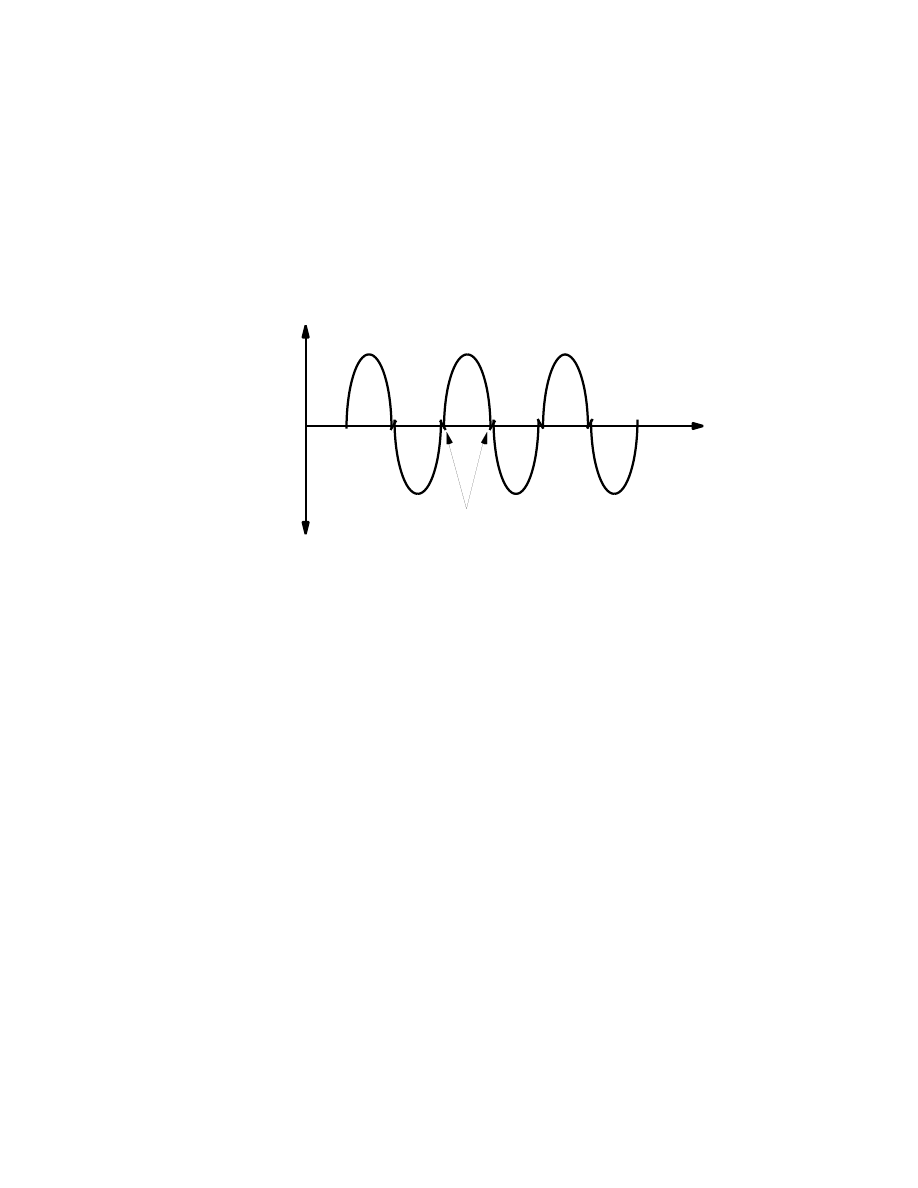ВУЗ: Казахская Национальная Академия Искусств им. Т. Жургенова
Категория: Учебное пособие
Дисциплина: Не указана
Добавлен: 03.02.2019
Просмотров: 12330
Скачиваний: 6

C
crossover distortion: A type of distortion present in some amplifiers which increases for
low-level signals. In many amplifiers, the output devices are connected so that one of them
is active during the positive half of the waveform, an the other one is active for the negative
half. There is a region near zero current where the signal is transferred from one to the
other. If this is not done smoothly, there will result a small discontinuity in the output
waveform. This discontinuity causes higher-order harmonic distortion, and being constant in
value, is more noticeable with low-level signals than with stronger ones. See crossover fre-
quency.
Distortion
Amplitude
Crossover
crossover frequency: The frequency above and below which an audio signal is divided into
two bands, each of which is directed to a separate destination. Precisely, the frequency at
which each of the two bands is attenuated 3dB by the crossover network.
crossover network: A dividing network that splits a full-spectrum signal into two or more
frequency bands and routes them to feed the various components of a speaker system. Pas-
sive crossover is a speaker design whereby multiple speakers are in a single enclosure and
sound frequencies are separated and sent to be driven by the appropriate speaker. A two-
way biamp monitoring system has a high-frequency loudspeaker (tweeter) and a low-
frequency speaker (woofer). A three-way triamp system has a third speaker to reproduce
midrange frequencies. Active crossovers divide a line-level output signal from a mixer or other
sound source and route the resulting signals to individual amplifiers optimized for the dif-
ferent speaker components.
cross-switching: A velocity threshold effect in a synthesizer in which one sound is triggered
at low velocities and another at high velocities, with an abrupt transition between the two. If
the transition is smooth rather than abrupt, the effect is called cross-fading rather than cross-
switching. Cross-switching can also be initiated from a footswitch, LFO, or some other con-
troller. Also called velocity-switching.
crosstalk: In multichannel audio transmission systems, such as tape recorders, record play-
ers, or telephone lines, a signal leaking from one channel to one or more of the others is
called crosstalk. Also known as bleeding. See channel separation.

C
crystal sync: A system for generating a sync signal that will ensure proper synchronization
of film footage and its corresponding sync sound without using any sync reference, such as
60Hz AC line frequency. Two piezoelectric crystals, each tuned to the same high frequency,
are installed in the camera and recorder. The crystal in the camera precisely controls the
motor speed during shooting. The crystal in the recorder produces a pilot tone that is re-
corded on tape in the same way which the camera motor speed would be recorded through
the conventional sync cable. Because the two crystals are tuned identically, the dailies, when
synched with the magnetic film copy of the original sound takes, will maintain perfect sync
once the slate marks are aligned. Crystal sync generators are also installed in portable video
cameras and VTRs. See Nagra, neo-pilot.
C-Type: See Spectral Recording, noise reduction.
cue: (1) (noun) A piece of music for a specific scene or event in a film. A specific part of a
film soundtrack which correlates to a visual event in the film is called a cue point or hit point.
(2) (verb) To position a sound source to activate at a specific time. See Real-Time MTC Cueing.
spot.
cue box: A wall-mounted or movable box that receives one or more monitor mixes from the
recording console, and that has jacks to plug in several sets of headphones used to send the
cue mix to singers or instrumentalists in overdubbing, a narrator, or other studio talent. Also
called a headphone box. See cue system.
cue line: A line drawn on the workprint, meant to be seen during projection in post-dubbing
or scoring, which gives the actor or conductor a visual cue to begin.
cue list/sheet: A list of the footages and frames, beginning with 00:00, at which specific
shots begin and end. Used by the re-recording mixer who needs to know which sounds or
music must be played as the final mix proceeds. See also edit decision list, feet/frames.
cue mix: The blend of live inputs and/or previously recorded tracks sent by the mixing en-
gineer to the headphones of performers playing or singing in the studio. Also called the
headphone mix.
cue mode: A tape machine operating mode in which the tape lifters are defeated while the
playback electronics remain operative. Used most often during editing, thus also called edit
mode.
cue point: See Real-Time MTC Cueing.
cue sheet: A track sheet for mixing that gives locations of edited sounds on a track-by-track
bases, either in film footages or in timecode numbers. See binky.
cue system: The entire electronic circuitry contained within the recording console that al-
lows the engineer to adjustably feed sound from any input module to the cue mix, then out to
the musicians’ or singers’ headphones via the cue amp and cue boxes.
cue track: A track of recorded music and/or clicks which are sent over headphones to the
musicians and/or singers to assist them in overdubbing additional music/vocals. If the track
is simply tempo clicks, it is known as a click track.

C
cue-up: To locate a desired point, at which a specific sound event happens on a reel of tape,
and to position that point just ahead of the playback head on a tape recorder. When playback
begins, the desired sound will be heard immediately.
current (I): The flow of electrical charge measured in amperes.
cut: (1) (verb) To attenuate amplitude of a signal or particular frequency band; the opposite
of boost. (2) To produce the master for a vinyl LP. (3) In film, the instruction used to termi-
nate filming. (4) (noun) A musical selection on a record, tape, or CD, or a particular edited
version of film.
cut-and-paste: On a hard-disk audio editing system, a term used to denote the ability of an
audio editing program to move and/or copy sections of the recorded audio to a new loca-
tion in the track or to other tracks.
cut effects: Sound effects that are taken from a sound library and edited, usually as opposed
to recorded Foley effects. See pull, M&E.
cutoff frequency: See rolloff frequency.
cut switch: A switch or button that mutes an audio signal on a mixer.
cutter: Sound editor.
cut track: An edited track of a film soundtrack which is ready to be used either as a track in
a premix (music or effects), or as a (dialog) track in the final mix.
C-weighting: Unlike A-weighting, C-weighting measures frequencies uniformly over the
audio spectrum. An SPL meter will allow the choice of either (or neither) weighting func-
tion. See B-weighting, equal loudness curves.


D
D/A: See digital-to-analog converter.
DAC: See digital-to-analog converter.
DAE: (1) Digidesign Audio Engine.™ A Macintosh application that can run behind other
applications, such as sequencers or ProTools,™ handling the transfer of audio data to/from
the hard disk. DAE is licensed by many sequencer developers to avoid writing their own
low-level I/O code. (2) Digital Audio Extraction. The process of capturing CD-Audio tracks
digitally from a CD-ROM drive to hard drive, using software such as Astarte’s CD Copy™
or OMI’s Disc-to-Disk.™
dailies: Uncut footage shot each day during production. If picture editing is on film, with
picture and synchronized mag film, those elements when edited together become the
workprint and worktrack. Used the chart the progress of the film and for preliminary music
cuts. Also called rushes.
daisy chain: See serial(2).
damping: (1) Damping is the addition of friction to a resonance in order to remove energy
from a mechanical system, reducing the magnitude of vibration at resonant frequencies. For
example, the reduction of movement of a speaker cone, due either to the electromechanical
characteristics of the speaker driver and suspension, or the effects of pressure inside a
speaker enclosure. The electrical analog of friction is resistance, and it is used to damp reso-
nating electrical circuits, such as crossover networks and filters. See also Q. (2) Acoustic fiber-
glass material used inside speaker enclosures.
damping factor: (1) A factor defined as the rated load divided by the amplifier output imped-
ance. (2) The ability of an amplifier to control the motion of a loudspeaker cone after a signal
disappears, i.e., its ability to defeat the natural ringing tendency of the body (cone) in motion.
An amplifier with a high damping factor looks more like a kind of short circuit to the
speaker, reducing its vibration when the signal stops. The damping factor of an amplifier
will vary with frequency, and sometimes a manufacturer will publish a curve of damping
factor vs. frequency. The effect of high damping factors is most audible at low frequencies,
where the primary resonance of the woofer cone, called hangover, is reduced in level.
DAR: See Digital Audio Recorder.
darkness: The amount of low-frequency, or corresponding lack of high-frequency, compo-
nents of a sound. Reverberation from distant objects usually has fewer high frequencies and
sounds darker than reverb from close objects. The opposite of brightness.